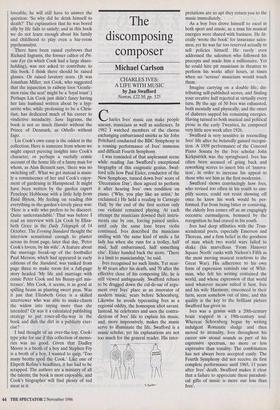The discomposing composer
Michael Carlson
CHARLES IVES: A LIFE WITH MUSIC by Jan Swafford Norton, £22.50, pp, 525 harles Ives' music can make people uneasy, musicians as well as audiences. In 1982 I watched members of the chorus exchanging embarrassed smirks as Sir John Pritchard conducted the BBC Symphony in a rousing performance of Ives' immense and difficult Fourth Symphony.
I was reminded of that unpleasant scene while reading Jan Swafford's exceptional biography of this enigmatic genius. Swaf- ford tells how Paul Eisler, conductor of the New Symphony, turned down Ives' score of `Decoration Day', then agreed to perform it after hearing Ives' own rendition on piano. ('Why, you play like an artist,' he exclaimed.) He held a reading in Carnegie Hall; by the end of the first section only one violinist remained playing. At each attempt the musicians downed their instru- ments one by one, forcing pained smiles, until only the same lone brave violin continued. Ives described the musicians smiling with 'the same kind of smile a fat lady has when she runs for a trolley, half mad, half embarrassed, half something else'. Eisler handed back the score. 'There is a limit to musicianship,' he said.
Ives recognised no such limits. Yet near- ly 40 years after his death, and 70 after the effective close of his composing life, he is still viewed ambiguously. Swafford refuses to be dragged down the cul-de-sac of argu- ment over Ives' place as an innovator of modern music, years before Schoenberg. Likewise he avoids typecasting Ives as a regional oddity, the homespun idiot savant. Instead, he celebrates and uses the contra- dictions of Ives' life to explain his music, and, more impressively, makes the music serve to illuminate the life. Swafford is a music scholar, yet his explanations are not too much for the general reader. His inter- pretations are so apt they return you to the music immediately.
As a boy Ives drove himself to excel in both sport and music, as a man his musical energies were shared with business. He lit- erally 'wrote the book' for insurance sales- men, yet he was far too reserved actually to sell policies himself. He rarely even addressed the salesmen who followed his precepts and made him a millionaire. Yet he could hire pit musicians in theatres to perform his works after hours, at times when no 'serious' musicians would touch them.
Imagine carrying on a double life, dis- tributing self-published scores, and finding your creative half rejected at virtually every turn. By the age of 50 Ives was exhausted, both mentally and physically, and the onset of diabetes sapped his remaining energies. Having turned to both musical and political prose in the early Twenties, he composed very little new work after 1926.
Swafford is very sensitive in reconciling Ives' life after he belatedly gained recogni- tion. A 1939 performance of the Concord Piano Sonata by the Ives scholar John Kirkpatrick was the springboard. Ives has often been accused of going back and reworking scores to insert bits of 'innova- tion', in order to increase his appeal to those who see him as the first modernist.
Swafford shows convincingly how Ives, who revised too often in his youth to sim- plify scores, could not resist showing off once he knew his work would be per- formed. Far from being bitter or conniving, the elderly Ives comes off as an engagingly eccentric curmudgeon, bemused by the recognition he had craved in his youth.
Ives had deep affinities with the Tran- scendental poets, especially Emerson and Thoreau, and a firm belief in the goodness of man which two world wars failed to shake (his marvellous 'From Hanover Square North' ranks with Nielsen's Fifth as the most moving musical reactions to the Great War). His adherence to his own form of expression reminds one of Whit- man, who felt his writing contained the world, and whose expression of that world used whatever means suited it best. Ives and his wife Harmony, ensconced in their farm, seem somehow out of time, and this quality is the key to the brilliant picture Swafford has given us.
Ives was a genius with a 20th-century brain trapped in a 19th-century soul. Whereas Schoenberg began by writing indulgent Romantic sludge and then moved to atonality, Ives throughout his career saw atonal sounds as part of his expressive spectrum, no more or less expressive than tonality. The combination has not always been accepted easily. The Fourth Symphony did not receive its first complete performance until 1965, 11 years after Ives' death. Swafford makes it clear that a failure to appreciate these paradoxi- cal gifts of music is more our loss than Ives'.


















































































 Previous page
Previous page